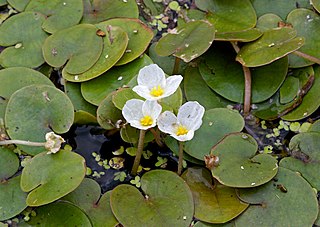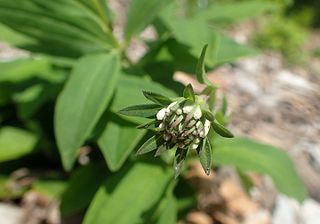
Botrychium is a genus of ferns, seedless vascular plants in the family Ophioglossaceae. Botrychium species are known as moonworts. They are small, with fleshy roots, and reproduce by spores shed into the air. One part of the leaf, the trophophore, is sterile and fernlike; the other, the sporophore, is fertile and carries the clusters of sporangia or spore cases. Some species only occasionally emerge above ground and gain most of their nourishment from an association with mycorrhizal fungi.

Sceptridium is a genus of seedless vascular plants in the family Ophioglossaceae, closely allied to the genus Botrychium. It is also closely related to the genus Botrypus. Sceptridium species are commonly called the grape-ferns.

Hoodia is a genus of flowering plants in the family Apocynaceae, under the subfamily Asclepiadoideae, native to Southern Africa.

Tibouchina Aubl. is a neotropical flowering plant genus in Melastomataceae Juss. that contains approximately 240 species. Species of this genus are herbs, shrubs or trees and typically have purple flowers. They are native to Mexico, the Caribbean, and South America where they are found as far south as northern Argentina. Members of this genus are known as glory bushes, glory trees or princess flowers. The name Tibouchina is adapted from a Guianan indigenous name for a member of this genus [2]. A recent systematic study has shown that this genus is paraphyletic.

Erik Acharius was a Swedish botanist who pioneered the taxonomy of lichens and is known as the "father of lichenology." Acharius was famously the last pupil of Carl Linnaeus.

Hydrocharis is a genus of aquatic plants in the family Hydrocharitaceae described as a genus by Carl Linnaeus in 1753. It is widespread across much of Europe and Asia, plus a few scattered locations in Africa. It is also reportedly naturalized in parts of North America.

Polystichum is a genus of ferns in the family Dryopteridaceae, subfamily Dryopteridoideae, according to the Pteridophyte Phylogeny Group classification of 2016. The genus has about 500 species and has a cosmopolitan distribution. The highest diversity is in eastern Asia, with about 208 species in China alone; the region from Mexico to Brazil has at least 100 additional species; Africa, North America, and Europe have much lower diversity. Polystichum species are terrestrial or rock-dwelling ferns of warm-temperate and montane-tropical regions. They are often found in disturbed habitats such as road cuts, talus slopes, and stream banks.

Physocarpus, commonly called ninebark, is a genus of flowering plants in the family Rosaceae, native to North America and northeastern Asia.
Tree moss is a common name for several organisms and may refer to:

Marshallia is a genus of plants in the sunflower tribe within the daisy family. Marshallia is native to the southeastern and south-central United States. A common name applied to most species in the genus is Barbara's buttons.

Phleum (timothy) is a genus of annual and perennial plants in the grass family. The genus is native to Europe, Asia and north Africa, with one species also in North and South America.

Cymodocea is a genus in the family Cymodoceaceae described as a genus in 1805. It includes four species of sea grass distributed in warm oceans.

Pholidostachys is a genus of palms found in Central America and northwestern South America.

Hygroryza (watergrass) is a genus of Asian plants in the grass family.
Irvingia is a genus of African and Southeast Asian trees in the family Irvingiaceae, sometimes known by the common names wild mango, African mango, bush mango, dika, mbukpap uyo or ogbono. They bear edible mango-like fruits, and are especially valued for their fat- and protein-rich nuts.

Maundia is a genus of alismatid monocots, described in 1858. Maundia was formerly included in the family Juncaginaceae but is now considered to form a family of its own under the name Maundiaceae. It contains only one known species, Maundia triglochinoides, endemic to Australia.
Harpanthus is a genus of liverworts belonging to the family Geocalycaceae.
Ptychostomum is a genus of mosses belonging to the family Bryaceae.
Conostomum is a genus of mosses belonging to the family Bartramiaceae.

Pottia is a genus of mosses belonging to the family Pottiaceae.















